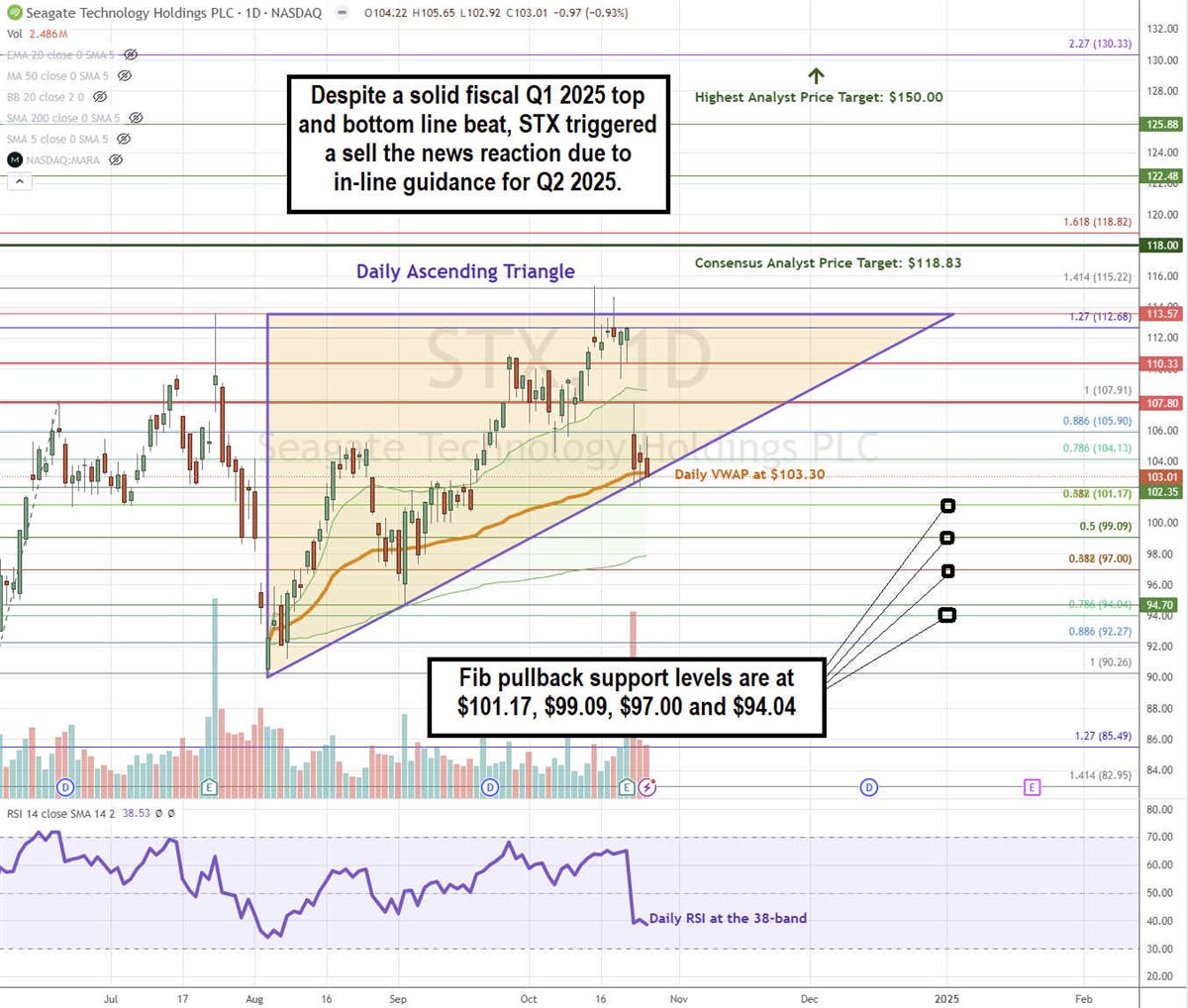Seagate Technology Today
STX
Seagate Technology
$82.73 -0.31 (-0.37%) As of 11:05 AM Eastern
This is a fair market value price provided by Polygon.io. Learn more. - 52-Week Range
- $63.19
▼
$115.32 - Dividend Yield
- 3.48%
- P/E Ratio
- 15.09
- Price Target
- $117.39
Seagate Technology Holdings PLC NASDAQ: STX is the world’s largest manufacturer of hard disk drives (HDDs), competing with Western Digital Co. NASDAQ: WDC, one of the largest makers of flash solid state drives (SSDs). After eight consecutive quarters of declining revenue facing normalization from the industry inventory glut, Seagate finally saw a revenue rise in fiscal Q4 2024, prompting a large guidance raise for the computer and technology sector leader in its fiscal first quarter of 2025.
Seagate reported even strong results of $1.58 EPS, beating consensus estimates by 4 cents, with revenues climbing a whopping 49.1% YoY to $2.17 billion, beating $2.13 billion consensus estimates. Investors expected a gap-up in the reaction but instead faced an 8% sell-off the following day in a sell-the-news reaction. Here are four reasons to use the sell-off as a buy-the-dip opportunity.
1) Seagate Technology May Have Purposely Low-Balled Forecasts
The key drivers were the artificial intelligence (AI) boom and cloud computing recovery. After the steep upside guidance in the previous quarter, markets were expecting a repeat of raised guidance. However, the computer and technology sector leader provided in-line guidance for the fiscal second quarter of 2025 EPS of $1.65 to $2.05 versus $1.74 consensus estimates and revenues of $2.15 billion to $2.45 billion versus $2.29 billion consensus estimates.
However, the conference call was extremely upbeat. Seagate Technology CEO Dave Mosley stated the potential for significant revenue growth for fiscal 2025 was inclusive of seasonal demand fluctuation typically in the March quarter. Margins are expected to expand even higher after the 10-year high of 33.3% achieved in Q1 2025 compared to 19.8% in the year-ago period.
2) Video and GenAI Are Cloud Providers to Beef Up Mass Storage Capacity with HDDs
U.S. cloud providers are experiencing the growing use of video content on e-commerce and social media platforms, which require significantly more storage capacity than images. This is because video is proving to be a much more effective format for engaging digital audiences, especially longer-form video, which is a boon for its HDD business.
HDDs hold nearly 90% of the data stored in public cloud environments. Seagate experienced the first meaningful nearline demand uptick in multiple quarters, pushing average capacity per enterprise surge to a new record high. Compared to NAND flash, HDDs offer a 6x lower cost per terabyte. HDDs have 10X lower embodied carbon per terabyte compared to NAND. HDDs are 9x more capital efficient than NAND flash storage alternatives.
3) HAMR Technology for HDD Is Best Suited for AI Data Centers
Seagate’s heat-assisted-magnetic-recording (HAMR) technology storage products can store significantly more data in the same amount of space due to greater data density on platters. HAMR enables data centers to store more data for less cost per terabyte (TB), which makes them best suited for new data centers running on AI technologies. HAMR products, like its 32 TB HDDs, are favorably undergoing the qualification process across several global cloud and enterprise customers.
Seagate expects HAMR shipments to ramp up by mid-calendar year 2025. Its mass capacity nearline storage HDDs, ranging from 8 TB to 20 TB, are used for bulk storage in data centers and are experiencing strong demand. As the data center infrastructure trend continues to build out, hyperscalers like Alphabet Inc. NASDAQ: GOOGL, Amazon.com Inc. NASDAQ: AMZN, and Microsoft Co. NASDAQ: MSFT will need to considerably increase their investments in mass data storage.
4) STX Is Attempting a Wider Ascending Triangle Pattern
An ascending triangle is a bullish pattern comprised of a flat-top upper trendline resistance converging with an ascending (rising) lower trendline support. The breakout occurs when the stock surges through the upper trendline resistance and trends higher.

STX formed the flat-top upper trendline resistance at $113.57, which it failed to break twice. The Q1 earnings sell-the-news reaction plunged shares back down to retest the ascending trendline support, which also overlaps with the daily anchored VWAP at $103.30. STX has to bounce higher from the lower trendline to stay in the ascending triangle. The pattern fails if STX falls under the lower ascending trendline support. The daily RSI fell to the 38-band. Fibonacci (Fib) pullback support levels are at $101.17, $99.09, $97.00, and $94.04.
Seagate Technology’s average consensus price target is $118.83, and its highest analyst price target sits at $150.00. It has 11 analysts' Buy ratings, 6 Hold and 2 Sell ratings. The stock trades at 14.53X forward earnings.
Actionable Options Strategies: Bullish investors can consider using cash-secured puts to buy STX at the Fib pullback support levels for entry and write covered calls to execute a wheel strategy for income in addition to the 2.80% annual dividend yield.
Before you consider Seagate Technology, you'll want to hear this.
MarketBeat keeps track of Wall Street's top-rated and best performing research analysts and the stocks they recommend to their clients on a daily basis. MarketBeat has identified the five stocks that top analysts are quietly whispering to their clients to buy now before the broader market catches on... and Seagate Technology wasn't on the list.
While Seagate Technology currently has a Moderate Buy rating among analysts, top-rated analysts believe these five stocks are better buys.
View The Five Stocks Here
MarketBeat just released its list of 10 cheap stocks that have been overlooked by the market and may be seriously undervalued. Enter your email address and below to see which companies made the list.
Get This Free Report
Like this article? Share it with a colleague.
Link copied to clipboard.